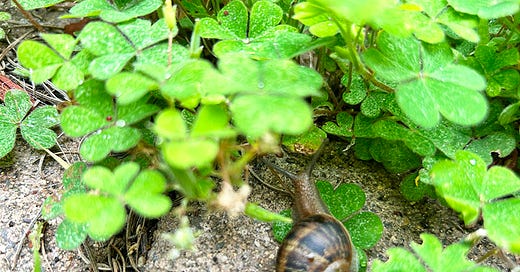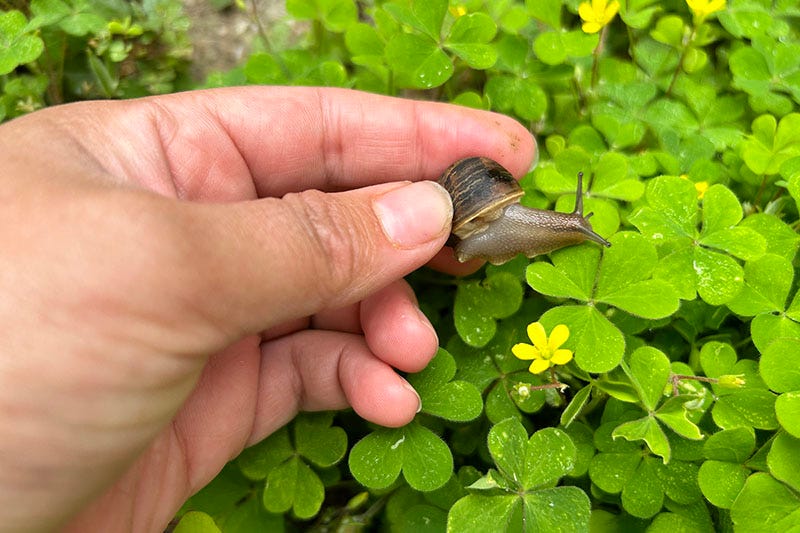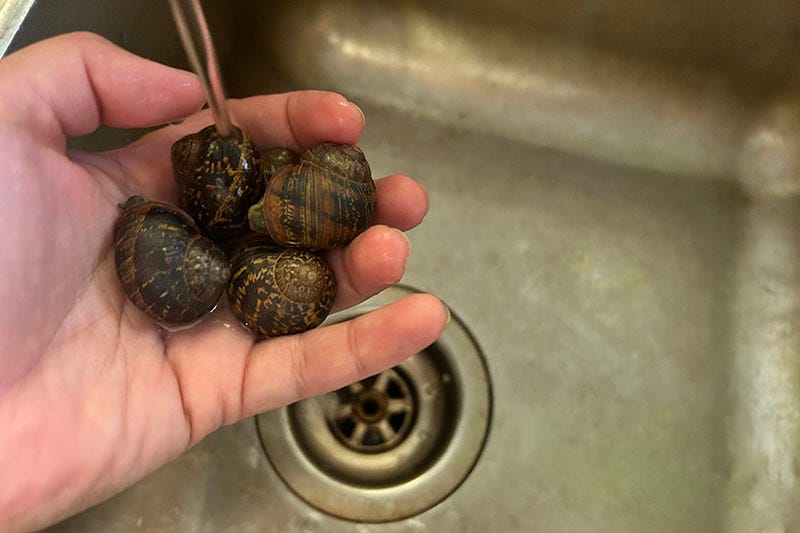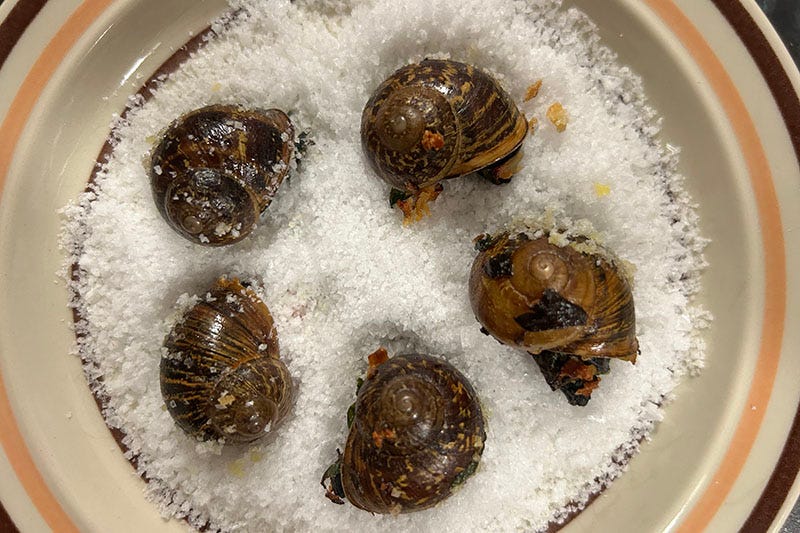When I started this newsletter just over a year ago, I intended it to be a space to talk solely about cooking and food.
But I am too, a gardener. I couldn’t write about one without the other. And I couldn’t talk about gardening without sharing the awe I feel for the natural world – and not only the ocean, the mountains and rainforests, that exist outside the city. I needed to write about the birds that live in local wild spaces. I want to consider the sole big tree down the road that sometimes yellow-tailed black cockatoos feast in. The critters I share my urban home with, often very much unwillingly.
If you start a passionate love affair with food and the kitchen, if you discover the pleasure of sinking hands into soil, if you make a practice of sitting in silence and listening to the world around you, I suppose it’s inevitable that you begin to think about where the food you consume comes from.
And within that, why we eat the foods we do. Why we’re perfectly content to pick up limp produce wrapped in plastic from the supermarket, with a price tag slapped on it, but feel weird about eating plants growing between the cracks in pavement, pulled from the ground. Freely available (although thanks to the levels of pollution in our cities, not without their own risks).
When you start thinking, really thinking about food, you start to see an abundance of options around you.
And accept a willingness that the way we eat in the future, may be VERY different from the way we eat now.
With that, let me share a recent experiment in the art of urban foraging.
Slow food: snacking on snails
I was flipping through a copy of Pip Magazine when I saw it.
A recipe for prepping, cooking and eating garden snails. Here, in Australia.
These snails, Cornu aspersum in the Latin, are not actually native to Australia. They’re introduced and are edible. Once cooked, not raw. Don’t ever eat snails or slugs raw.
On reading this, I thought: “Well, why not give it a go. I did a juice cleanse for three days, and so clearly have no respect for what I do with my body.”
I have eaten snails before (in France, bien sûr) and really enjoyed them. Or, I think I have always adored garlic, and escargot is basically a delicious vehicle for the tastiest member of the onion fam. Throw butter into the mix and you have a real winner.
Obtaining snails
First item on the to-do list – track down some snails.
This is surprisingly difficult. Maybe I don’t go outside enough after rainfall anymore, but I don’t see heaps around my neighbourhood. I did find one while weeding and eagerly set it aside. Went inside to get a container – during that short period of time, a bird got to it. Sorry snail, RIP.
The next time I found one in the garden, I didn’t make the same mistake. All in all, I collected six snails, figuring that was enough for a meal. Or a light snack, at the very least.
An important note here, for any kind of urban foraging: only collect fruit, veg, weeds and as it turns out, snails from places you know are free from toxins, pesticides and any other nasties. This can be difficult in an urban setting for sure, so perhaps your own garden is the safest bet.
There is a process you can follow for ‘purging’ snails of toxins, which is outlined below.
During this time, we had a box of worms living on the table (I was redoing my worm farm after accidentally frying the last lot in the sun, clearly accidentally on a gastropod/invertebrate killing rampage here), and two takeaway containers of snails on the kitchen counter. My partner had not commented on this at all.
One day, I asked him if he was at all curious. He shrugged in a world-weary sort of way.
“I am too grossed out to wonder why.”
In the end, I whittled the gastropod group down to five, as one seemed just a bit too small to eat. Best to let it survive and thrive in the garden.
Oh and of course four days before I cooked the snails, it bucketed down cats and dogs. I took the dog for a walk once the rain had eased and saw about thirty out and about. C’est typical.
Prepping the snails
I spent a month feeding the snails what I hope were delicious treats. Parsley and celery leaves, river mint from my small native plant garden, a bit of kale. Yum, yum.
Why do this? Well, then you know they’re eating herbs, leaves, whatever, that are free from pesticides. Very important. Our system may not be able to handle their natural diet, so best bet is to feed them some of ours.
I ended up quarantining the snails for over 30 days before eating, really only because I read it as a suggestion in The Age.
Doing some more reading on this topic online, I discovered another hack, which is to give them carrot after they’ve had a few days of gourmet snacking. Feeding them this turns their poo orange; you then know they’ve expelled whatever else may be in their gut.
A couple of days before cooking, I moved the snails into another container, free from food. This allows them to ‘purge’ their digestive systems, further expelling any toxins they have have inadvertently gathered.
It may seem a bit cruel to essentially starve them. It’s up to you – just remember that these little fellas poop A LOT, so if you’re okay with eating that, then I suppose you can skip this phase.
Cooking the snails
Well. Here we go.
One thing I do recommend, for the sake of a humane death, is freezing your snails before cooking them. This apparently sends them into a sort of hibernation and seems kinder than straight out boiling them.
I felt a bit funny, coming up to this part of the process. Kinda bonkers, as I’m sure I accidentally step on snails all the time. Yet, I suppose I’d lived with this group, had fed them and got used to them being around. But if you’re going to eat something that once was alive, then it’s good to properly think about where it’s come from. And we’re all guilty of mass insect death. Even if you’re on a strict vegan diet, you can guarantee insects have been killed during the production of the fruit and veggies you consume.
After some time in the freezer, I filled a pot with heavily salted water. Once on the boil, I dropped the snails in and cooked them for three minutes.
I let the snails cool down, then worked on getting them out of their shells. This was the trickiest bit as I only had a small pair of tweezers on hand. The first one came out no problem, but I quickly realised it was the biggest and so, the easiest to detach. A bit of a process with the rest, but I got there in the end.
I then, again on instruction, deslimed the snails, after removing them from their shells. I’d lived with this lot for over a month and had seen just how slimy they could get.
At this point, my boyfriend came home from work and looked around the kitchen, noticing the empty shells on the counter.
“Oh no,” he said.
The PIP recipe contains butter, garlic, onion and bread. I however, decided to make escargot. Here’s the recipe I used… if you’re interested(?!).
The verdict
Pulling the snails from the oven, I have to say… they smelt delicious. I suppose the scent of butter and garlic, intertwined, will have that effect.
And, how did they taste?
Well. Not bad at all. The parts in the shell tender, the outer bits crispy. There wasn’t much to them size-wise, in the end. Would describe the taste as kind of vinegar-ish thanks to the desliming method, but also buttery and yes, garlicky. My mind was really kicking off against the experience. But my taste buds… kinda liked it? It rather reminded me of eating garlic mushrooms, texture-wise.
I’d probably say this particular dish is a supposedly fun thing I’ll never make again. The process of cooking them is pretty labour intensive, not really matched by the payoff. And that’s without the month’s worth of prep… and judgement from any other members of your household.
If you found this at all interesting, you may be pleased to know that I’ll be writing up guides to getting to know your bio-region, alongside tips for urban foraging (things you may possibly have more of an interest in eating?) in this year’s bumper editions – exclusively for paid subscribers.
Garden plans for 2024
Many of my resolutions/monthly goals these days revolve around where I want to eat and what I want to grow. And while I have a ton of individuals goals for glowing up the green thumb, there are two in particular that outshine the rest:
Become a composting expert
Establish a portable kitchen garden of native Australian ingredients.
The first one is hopefully self-explanatory – ensure my home becomes a circular economy, where food is not wasted, rather put to good use. Plus good compost = great growing conditions.
The second is something that’s long been a bugbear. Edible indigenous plants are hard to source and require completely different conditions and care to introduced species.
Living now the full fantasy of walking into the garden to pluck produce for use in the kitchen, I’m hoping anything I grow can be incorporated into my cooking. So far, my river mint is borderline out of control and native violets doing very well, but it’d be grand to have an array of indigenous edible and medicinal plants in the garden.
I’ll aim to record progress here on a monthly basis – and if this is something that interests you, feel free to take part too!
Some recommendations
Read: No specific recommendations this fortnight. There was a whole section on ‘thought-full’ reads for the new year, which was sent out as a standalone edition last week. Here if you missed it.
Listen: If you’re active in the permaculture/gardening community, you may have been an avid listener of the podcast Futuresteading (and if this podcast has never graced your earbuds, I invite you to listen to the entire back catalogue and consider this two recommendations in one). Formerly hosted by both Jade Miles and Catie Payne, Futuresteading is sadly on indefinite hiatus… however Catie has recently released her own podcast, Reskillience. As the name may suggest, this pod is about skilling up and building resilience in the face of a changing world and climate. I am personally VERY interested in this, spending a lot of time lamenting my lack of both practical and survival skills (first one to be eaten in the zombie apocalypse for sure). Catie has a most delightful way with words, whether on page (screen?) or spoken, and this topic is endlessly intriguing, so tune in wherever you get your pods.
Watch: I dunno what it is about summer, but all I want to watch are good (or bad, I’ll take either) 90s thrillers. My two favourite sub-genres of this are specifically legal thrillers and ‘Michael Douglas’. Basic Instinct is a longtime favourite, and I’ve been working my way through Paul Verhoeven’s back catalogue of films, thoroughly enjoying Total Recall, looking forward to viewing Starship Troopers and wondering whether it’s worth braving Showgirls. Also have thoroughly enjoyed getting lost in the many movie adaptations of renowned airport author John Grisham, alongside Primal Fear, featuring a young Edward Norton who somehow also looks like the Edward Norton of today? The man must age backwards.
Eat: A lifelong seafood fanatic, I’ve sadly cut down on my consumption of fruits de mer in recent years, due to the plastic packaging that often comes with purchase. Fortunately, a local grocery store has started stocking the wares of Ash Bros, who pop their yummy range of Australian and New Zealand seafood in recyclable packaging. One of the most effective ways to vote is of course with your wallet, so support businesses using compostable and plastic-free packing where you can.
Thanks for reading what has turned out to be a long newsletter! I hope your 2024 is going swimmingly so far.
Another hopefully not too annoying reminder that the very first bumper-edition of What’s Cooking will be hitting your inbox in two weeks time, and is free for all subscribers for 48 hours from go-live. Future editions will be paywalled; accessible for paid subscribers only.
‘Til then, stay well and well-fed.
-Celine
Likes, comments and shares are loved (by both moi and dreaded internet algorithms).
As this edition contains a somewhat whacky food-related experiment, I must note that I am not a nutritionist, dietician or any sort of medical expert. As mentioned, snails can contain pesticides and poisons from the garden, which even purging them cannot fully eradicate. As with any kind of urban foraging, proceed with caution and consume at your own risk – What’s Cooking with Celine cannot take responsibility for any reader becoming ill after eating wild food.







This is one of the most impressive and terrifying things you've done. I am absolutely not brave enough to try anything like this but am so glad you did so I could live nervously and vicariously through you!
Edward Norton is definitely one of those Hollywood people who froze in time. And Showgirls is unfortunately gonna probably be essential viewing. I don't think I have the mental fortitude to try to eat snails, but an interesting way to delve into where "food" comes from for a city slicker.